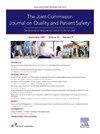The Frequency of Multiple Central Line–Associated Bloodstream Infections (CLABSIs) Occurring in the Same Child: A Five-Year Experience
IF 2.4
Q2 HEALTH CARE SCIENCES & SERVICES
Joint Commission journal on quality and patient safety
Pub Date : 2025-07-01
DOI:10.1016/j.jcjq.2025.04.006
引用次数: 0
Abstract
Background
The aim of this study was to evaluate one institution’s five-year experience with the frequency of multiple central line–associated bloodstream infections (CLABSIs) occurring in the same child and to discuss the importance of previous CLABSI as a risk factor for future CLABSI and the implications for CLABSI rate calculation.
Methods
The infection surveillance system includes data on central line days, CLABSI rate, and CLABSI count, including mucosal barrier injury (MBI) and non-MBI CLABSIs. Using this data, the authors determined the number of children who had more than one inpatient CLABSI during a five-year period. The team then calculated the percentage of total CLABSIs that are represented by patients with more than one CLABSI and the percentage of patients with CLABSI who had multiple CLABSIs.
Results
During the five-year study period, there were 138 CLABSIs in 119 patients. Of the 138 CLABSIs, 36 (26.1%) occurred in children who had more than one CLABSI and 19 (13.8%) of those were repeat. Seventeen patients had more than 1 inpatient CLABSI (15 patients with 2 CLABSIs, and 2 patients with 3 CLABSIs). The CLABSI rate for this period was 1.83 per 1,000 central line days. With exclusion of repeat CLABSIs, the CLABSI rate would be 1.58 per 1,000 central line days, representing a 13.7% difference.
Conclusion
Repeat CLABSI in the same patient is not uncommon and can contribute significantly to overall inpatient CLABSI rates. Prior CLABSI should be considered a risk factor for future CLABSI.
同一儿童发生多重中心线相关血流感染(CLABSIs)的频率:一项5年的经验。
背景:本研究的目的是评估一家机构在同一儿童发生多重中心线相关血流感染(CLABSI)频率方面的五年经验,并讨论既往CLABSI作为未来CLABSI风险因素的重要性,以及对CLABSI发生率计算的影响。方法:感染监测系统包括中心线天数、CLABSI率和CLABSI计数数据,包括粘膜屏障损伤(MBI)和非MBI CLABSI。利用这些数据,作者确定了在5年期间有一次以上CLABSI住院儿童的数量。然后,研究小组计算了由一个以上CLABSI患者代表的CLABSI总数的百分比,以及CLABSI患者有多个CLABSI的百分比。结果:在5年的研究期间,119例患者中有138例clabsi。在138例CLABSI中,36例(26.1%)发生在有一个以上CLABSI的儿童中,其中19例(13.8%)是重复的。17例患者有1例以上的住院CLABSI(15例有2例CLABSI, 2例有3例CLABSI)。这一时期的CLABSI汇率为1.83 / 1000中心线日。排除重复CLABSI后,CLABSI发生率为1.58 / 1000中央线日,差异为13.7%。结论:同一患者重复CLABSI并不罕见,并且可以显著提高住院患者CLABSI的总体发生率。既往CLABSI应被视为未来CLABSI的危险因素。
本文章由计算机程序翻译,如有差异,请以英文原文为准。
求助全文
约1分钟内获得全文
求助全文
来源期刊

Joint Commission journal on quality and patient safety
HEALTH CARE SCIENCES & SERVICES-
CiteScore
3.80
自引率
4.30%
发文量
116
审稿时长
49 days
 求助内容:
求助内容: 应助结果提醒方式:
应助结果提醒方式:


